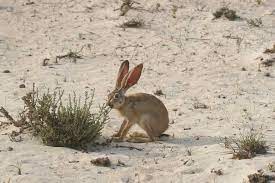In the heart of the vast Arabian Desert, a creature roams the seemingly inhospitable terrain with remarkable grace and resilience. Meet the Arabian Desert Hare, a species that has mastered the art of survival in one of the world’s most challenging environments. In this blog, we will explore the captivating life of the Arabian Desert Hare and uncover the secrets behind its ability to thrive in the harsh desert landscape.
- Discovering the Arabian Desert Hare:
The Arabian Desert Hare, Lepus capensis arabicus, is a subspecies of the Cape Hare, found exclusively in the arid regions of the Arabian Peninsula. Known for its exceptional speed and agility, this hare is uniquely adapted to navigate the extreme conditions of the desert.
- Physical Adaptations:
The Arabian Desert Hare boasts a set of physical adaptations that make it well-suited for desert life. Its large, powerful hind limbs propel it through the sandy dunes at incredible speeds. The long ears help dissipate heat, regulate body temperature, and enhance hearing, allowing the hare to detect predators from a distance.
- Nocturnal Lifestyle:
To avoid the scorching heat of the day, the Arabian Desert Hare is primarily nocturnal. It remains hidden in burrows or beneath shrubs during the day, emerging at dusk to forage for food. This behavioral adaptation helps conserve energy and reduce water loss during the hottest hours.
- Diet and Water Conservation:
The Arabian Desert Hare is a herbivorous animal, feeding on various desert vegetation such as grasses, leaves, and seeds. It has evolved to extract most of the water it needs from the plants it consumes, reducing its reliance on external water sources.
- Camouflage and Protection:
In the arid desert landscape, blending in is essential for survival. The Arabian Desert Hare’s fur coloration matches the sandy terrain, providing effective camouflage from potential predators like desert foxes, owls, and eagles. When startled, it can reach speeds of up to 40 miles per hour, making it challenging for predators to catch.
- Breeding and Reproduction:
The Arabian Desert Hare follows a breeding pattern that aligns with the availability of food and water. After a gestation period of about 40 days, the female gives birth to a litter of two to four leverets (young hares). These leverets are born with open eyes and a thick coat of fur, which enables them to survive and adapt quickly to their desert environment.
- Role in the Ecosystem:
The Arabian Desert Hare plays a crucial role in the desert ecosystem as both a prey and a predator. Its herbivorous diet influences plant populations, while its presence attracts predators, maintaining a balanced ecological cycle.
- Conservation Status:
While the Arabian Desert Hare has managed to survive in its harsh habitat, it faces challenges due to human activities such as habitat degradation, hunting, and the introduction of non-native species. Conservation efforts are essential to protect its unique ecological niche and ensure its survival for generations to come.
Conclusion:
The Arabian Desert Hare is a testament to the remarkable adaptability of life in extreme environments. Through a combination of physical, behavioral, and ecological adaptations, this hare has successfully carved out a niche in the unforgiving Arabian Desert. As we marvel at the resilience of this magnificent creature, we are reminded of the delicate balance of nature and the importance of preserving these exceptional species that enrich our planet’s biodiversity.




















Add Comment